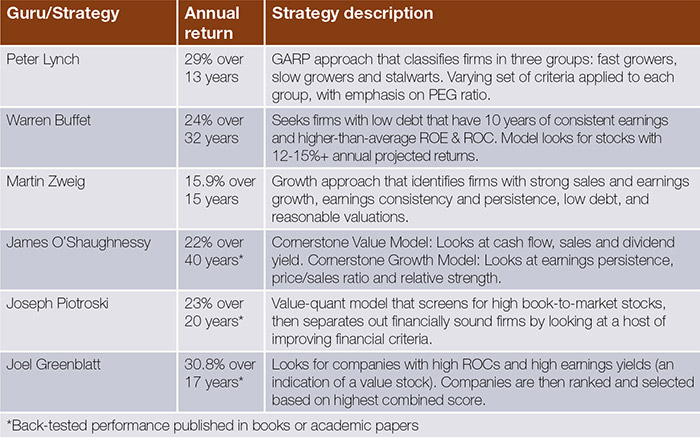
Investors are fascinated by the “new.” They are drawn to new companies with new products. They are keen on new strategies that promise to have figured out the market’s secrets. Give them the choice between a new strategy based on something topical and a value-investing approach developed 65 years ago, and you can bet most won’t think twice about going with the latest thing.
But as exciting as the “new” might be, the time I’ve spent studying history’s most successful investors has taught me this: In the stock market, “old” frequently beats “new.” Gurus like Warren Buffett, Benjamin Graham, Martin Zweig, and Peter Lynch not only developed long-term strategies to beat the market—they also disclosed their mostly or completely quantitative approaches in published books or papers. And the gurus’ strategies—some of which were developed more than six decades ago—are still very effective today.
Take my Benjamin Graham-inspired model, one of a dozen computerized “Guru Strategies” I developed after researching history’s best strategists. It’s based on a quantitative approach Graham outlined way back in 1949. Since I started tracking it nearly 12 years ago, a 10-stock model portfolio picked with the strategy is up 294% versus 111% for the S&P 500 (through June 22, 2015; returns exclude dividends).

Graham and other gurus’ strategies don’t keep working because of financial alchemy. They work because they focus on real, enduring principles of good business and good investing. The metrics they employ are timeless ways to measure business performance and share valuation.
Finding a winning strategy is only half of the battle. How you employ it is also critical. There are a few important tenets to keep in mind.
Combining “Guru Strategies”
A limited number of stocks appeal to more than one of these proven strategies at any given time. Stocks that get multi-guru-strategy
approval are thus very strong across a wide range of fundamentals and more likely to perform well.
Stick to the numbers
Even astute investors make mistakes because they let emotion drive their decisions. By following quantitative strategies and buying and selling only at regularly scheduled intervals, the cold, hard numbers tell you how attractive a stock or sector is—not your emotions.
Stay the course
In today’s world of instant data access and 24-hour financial news, there are continual reminders when your strategy goes through a down period. A crucial part of investing is allowing a long-term strategy to work by sticking with it through short-term ups and downs. Adhering to a proven strategy style makes you a long-term investor—even if you sometimes sell stocks in shorter-term time frames if their fundamentals deteriorate.
You can’t beat the market by owning it
Holding too few stocks may lead to unnecessary risk. Conversely, mutual funds that own 500 stocks are going to closely track the returns of the market. Studies show that the benefits of diversification become limited after 50 holdings.
Don’t limit investment possibilities
Good investments can be found in different market segments at different times. Why limit yourself to a particular style (such as small-cap growth stocks), when at any given time you may be able to find better opportunities in other areas of the market?
Follow the leaders
No strategy beats the market all of the time. But history’s best investors succeeded because they developed and stuck with fundamentally sound approaches during good times and bad. We’re lucky that so many have shared their investing blueprints with us. Take advantage of their wisdom.
The opinions expressed in this article are those of the author and do not necessarily represent the views of Proactive Advisor Magazine. These opinions are presented for educational purposes only.
 John P. Reese is co-founder of Validea Capital Management. He is the manager of Validea Capital’s active equity ETF and separate accounts. Mr. Reese is the author of “The Guru Investor: How to Beat the Market Using History’s Best Investment Strategies.” He is a graduate of MIT and Harvard Business School and holds two patents in the area of automated stock investing. Follow John’s thoughts and ideas at www.validea.com/blog or on Twitter at @guruinvestor.
John P. Reese is co-founder of Validea Capital Management. He is the manager of Validea Capital’s active equity ETF and separate accounts. Mr. Reese is the author of “The Guru Investor: How to Beat the Market Using History’s Best Investment Strategies.” He is a graduate of MIT and Harvard Business School and holds two patents in the area of automated stock investing. Follow John’s thoughts and ideas at www.validea.com/blog or on Twitter at @guruinvestor.
